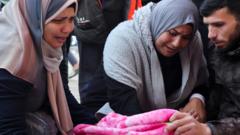A recent study published in The Lancet medical journal has revealed alarming potential discrepancies in the reported death toll from the ongoing war in Gaza, suggesting that the number of casualties could be drastically underreported. The research indicates that the actual number of Palestinian deaths could be as high as 64,260, a figure that marks an under-reporting of 41% compared to the official statistics provided by the health ministry in Gaza, which is run by Hamas.
The war, ignited by a Hamas-led attack on Israel on October 7, 2023, has drawn international attention due to the staggering casualties involved. The UK-led research, covering the initial nine months of the conflict, utilized a mix of data sources, including reported fatalities from the ministry, online surveys of relatives, and obituary analysis. It quantifies traumatic injury deaths from the conflict, shedding light on the devastating impact of hostilities.
While the Palestinian health ministry's numbers are often regarded as authoritative by United Nations observers, they do not differentiate between civilian and military casualties. A recent UN report indicated that a significant majority of those verified as victims during a six-month assessment were women and children. Contrarily, Israeli authorities, including the Israel Defense Forces (IDF), have independently stated that their efforts have predominantly targeted Hamas operatives, claiming they have "eliminated over 17,000 terrorists." However, they continue to face skepticism about the validity of their death toll claims.
The study employed "capture-recapture" methodology—an established statistical technique for estimating death counts in conflict zones—allowing researchers to cross-reference various records of fatalities. This overlap suggests that the documented death toll related to traumatic injuries could be far greater than what the Gaza Health Ministry reports on a daily basis.
The Lancet's estimates range between 55,298 and 78,525 deaths, in stark contrast to the health ministry's report of 37,877 fatalities at the time. Variations in these numbers hinge on the complexities of identifying deaths resulting from traumatic injuries, indicating that slight miscalculations could significantly sway the estimates.
Moreover, the analysis found that of the identifiable casualties, 59% were women, children, or the elderly, highlighting the war's catastrophic toll on non-combatants. The ongoing conflict has seen a swift escalation of hostilities, with the initial Hamas strike resulting in around 1,200 deaths in Israel and extensive military retaliation that has led to the deaths of approximately 46,006 people in Gaza, as reported by the health ministry, most of whom are civilians.
As the tragic consequences of the conflict continue to unfold, the study calls for urgent reassessment of mortality rates and renewed attention to the humanitarian crisis in the region while grappling with obstacles regarding the verification of facts on the ground due to restrictions on international media access.





















